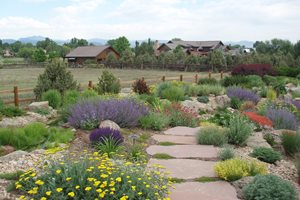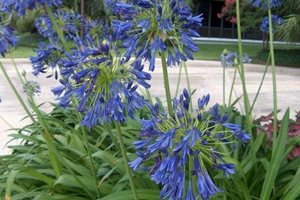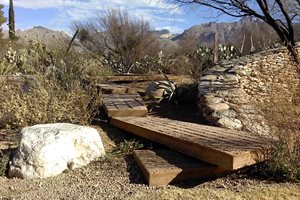Xeriscape Plants
See plants for xeriscaping growing in professionally designed landscapes Genevieve Schmidt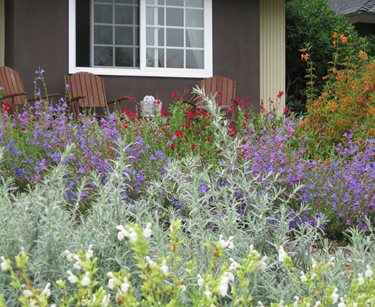
Native plants are a great choice for the xeric landscape.
"Plants that are native to your area have already adapted to the local climate, and thus can tolerate the weather conditions much better than non-natives," says Rama Nayeri of Creations Landscape Design in Tustin, CA. "For almost every non-native plant there is an equally suitable native option." Natives also bring the added benefit of attracting wildlife. Local birds, hummingbirds, and butterflies are already used to finding food and shelter and your region's native plants. In this garden, Nayeri used foothill penstemon, monkey flower, and a variety of native sages for long-lasting color.
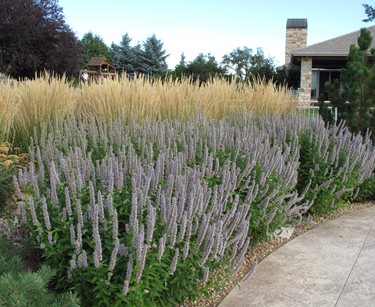
Plant perennials and grasses en masse for efficient irrigation and maintenance.
In this landscape, Agastache "Blue Fortune" is massed with Karl Foerster feather reed grass. Besides the obvious drama of a large-scale planting, the benefits to using plants in large swathes are twofold. First, it's easier to provide for the specific needs of each plant when they are grouped together, and thus avoid overwatering. Second, a large grouping makes for easier maintenance. "You can come in and deadhead the entire mass of perennials as though it were one plant," says Mike Woods of J&S Landscape in Longmont, CO. This saves a great deal of time and maintenance over landscapes with a one-of-this, one-of-that planting philosophy.
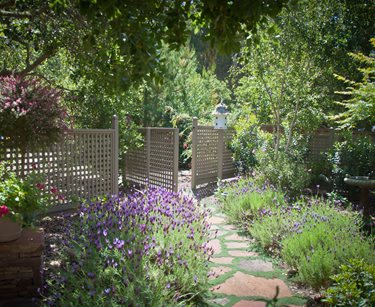
Give your plantings enough space to grow to mature size. Here, Spanish lavender was perfectly placed to accent the pathway without overwhelming it.
"It's important to give plants enough room to fill in," says Greg Frugoli of Ecotones Landscapes in Cambria, CA. "I trust the Sunset Western Garden Book's recommendations for width, and make sure to space the plants generously to allow the plants to grow into their natural form without crowding." This is especially important with woody shrubs, which can become stunted or develop a crooked habit when crammed in too closely with other mid-sized plants. The xeric benefits to careful planting design are obvious; fewer plants means less water needs to be applied to the landscape.
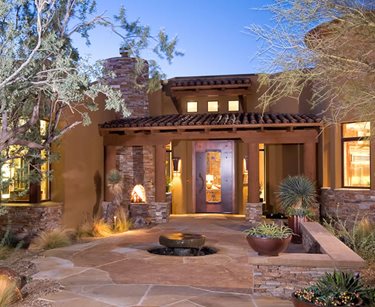
When choosing container accents for a xeriscape, consider shallow pots.
"These shallow pots are a smart choice for a xeriscape because they keep low-water plants happy," says Elizabeth Przygoda-Montgomery of Boxhill Landscape Design in Tucson, AZ. "It's more practical than filling a huge pot full of useless soil you don't need. Low-water plants don't need all that dirt, because it holds the water and gives xeric plants root rot." In this landscape, a shallow-rooted pot acts as a focal point and echoes the shape of the sunken water feature.
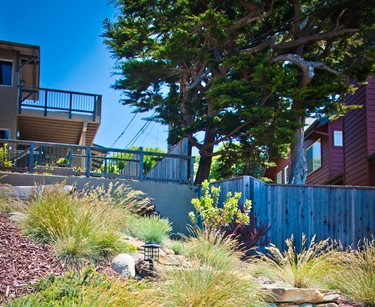
Drip irrigation is a critical tool in a xeric landscape.
"It's a good idea to always have an irrigation system available," says Frugoli. "It just takes the guesswork out of watering." Even if you plan to reduce or mostly eliminate the water use in your landscape once the plants are mature, it's tough to get plants thoroughly established without the regular, deep, automated watering provided by a drip system.
In this landscape, native California fescue requires little supplemental water, but still benefited from a drip system during that critical first summer. In gardens that have more plants, Frugoli recommends using drip irrigation laid out in a grid with in-line emitters every 12". "I like that system because wherever you put a plant, you already have good coverage," says Frugoli.
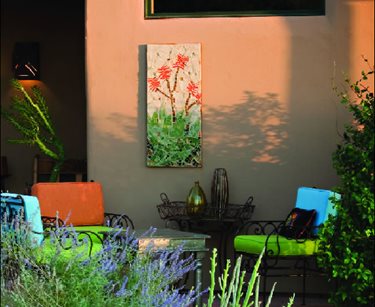
Harmonize your outdoor decor and paint colors with the plantings.
In this space, the fresh colors of the landscaping are repeated in the chair cushions. The designer also selected local art which goes with the style of her plantings, and repeated colors from the artwork elsewhere in the decor. "The colors of the low-water plants, soft shrubs mixed with accents, create a beautiful frame for the colors of the cushions and the art on the wall," says Przygoda-Montgomery. The mosaic art shown is by Robyn Riley Mosaics, and the fabric is from Perennials Outdoor Fabrics.
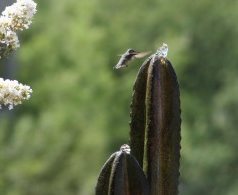
Are water features compatible with a xeriscaped, eco-friendly backyard? With the right design choices, absolutely!
This fountain cast from stone was made by a local Arizona sculptor, and when not in use it blends with the desert surroundings. "I love designing with natural elements that imitate nature," says Przygoda-Montgomery. In order to avoid excess evaporation, the water reserve is buried underneath the fountain. To save electricity, it's hooked up to a timer on a switch so it's not running all day long when everyone's at work.

 Backyards
Backyards
 Front Yards
Front Yards
